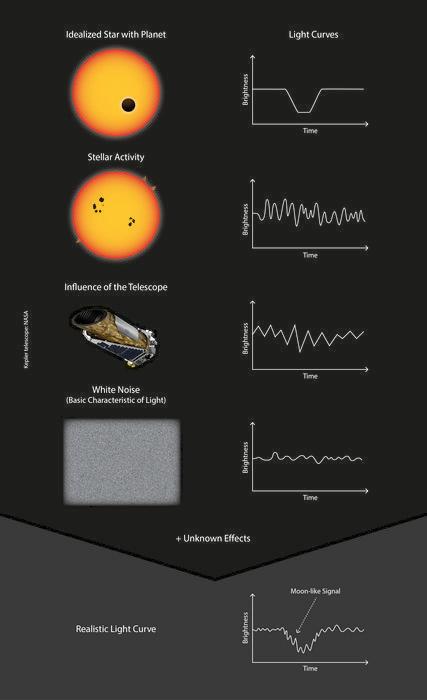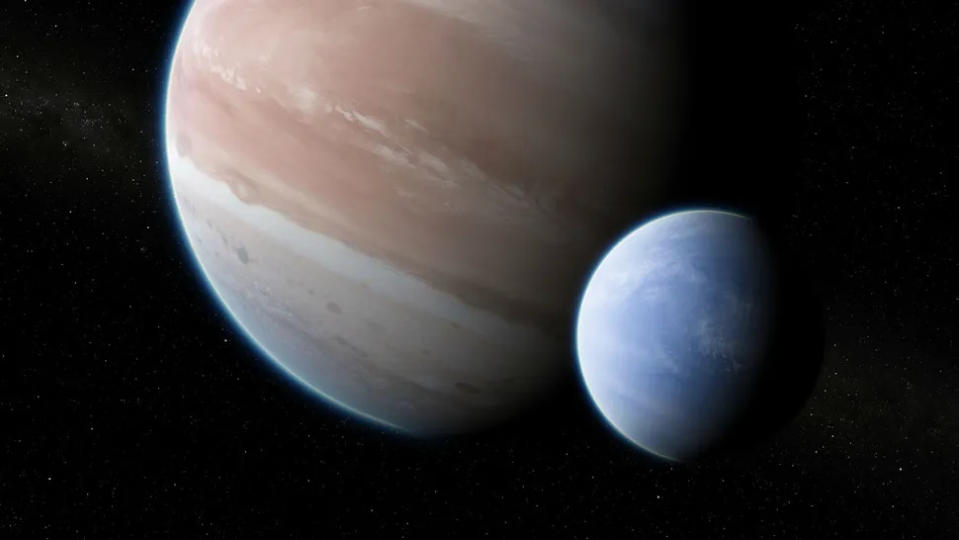Astronomers always knew that discovering moons around extrasolar planets would be no easy feat – but a debate currently raging in planetary science circles shows just how difficult detecting these so-called exomoons will be.
The story begins in 2018, when astronomers including David Kipping, an assistant professor of astronomy at Columbia University, believed they had detected an exomoon for the first time. The subject was found orbiting exoplanet Kepler-1625b, a Jupiter-like world about 8,000 light-years from Earth. Initially it was observed with the Kepler Space Telescope.
After its alleged discovery, Kepler-1625b’s moon was aptly named “Kepler-1625 b I”. Later, this was apparently further confirmed with data from the Hubble Space Telescope. Then in 2022, another team, including Kipping, appeared to be one second exomoon, this time only with the Kepler Space Telescope. This subject is said to have been seen orbiting Kepler-1708 b, a gas giant about 5,400 light-years from Earth with a mass 4.6 times that of Jupiter. The potential second exomoon had a similar name to the first; it was designated “Kepler-1708 b I.”
Related: That’s no moon! Scientists doubt the proposed detection of the first exomoons
These two moons were like nothing found in the solar system. They both exhibited sizes larger than Earth’s, making them comparable in scale to a class of exoplanets called “mini-Neptunes.” In that regard, the first exomoons seemed to mirror some of the earliest discoveries of exoplanets, including things scientists didn’t expect to see, like Jupiter-sized worlds snuggling up against their stars and planets orbiting rapidly spinning neutron stars that are called pulsars.
Although the discoverers of Kepler-1625 b I and Kepler-1708 b I – let’s call them ‘team pro-exomoon’ – were open to the existence of the moons, and to this day still insist on healthy skepticism, it seemed fairly certain that humanity had found its first exomoons after decades of exclusively locating exoplanets.
That was until late 2023, when a separate team of astronomers led by Max Planck Institute for Solar System Research scientist René Heller – “team no-exomoon” if you will – questioned both exomoon discoveries in a paper published in the journal Nature Astronomy. .
Kipping and colleagues have now fired back, producing a research paper that appears in a preprint version of the paper repository arXiv and defending their exomoon findings.
“I believe that Kepler-1625b and Kepler-1708b are perfectly valid exomoon candidates, and I think we’ve shown that convincingly,” Kipping told Space.com. “So what do I think is really going on, and why didn’t they get the moon?”
An exomoon discrepancy
The technique used to detect these two exoplanets is similar to the transit method, which has so far yielded a large portion of the more than 5,000 planets in the exoplanet catalogue.
The transit method depends on detecting a small dip in light coming from a planet’s parent star, created as that world crosses or ‘transits’ the plane of that star from our vantage point in the cosmos. The same principle applies to exomoons, albeit on a much smaller scale. If these moons are in just the right position around the planet, orbiting as that planet moves past its star, then that should also cause a light dip, albeit a more insignificant one.
However, such a mini light dip is the clue that suggested the existence of Kepler-1625 b I and Kepler-1708 b I for team pro-exomoon. But because this dip in light output caused by the passage of an exomoon is so small, it cannot be observed directly. Instead, powerful computer software algorithms are needed to extract it from telescope data.
Kipping says that both his ‘pro-exomoon’ team and Heller’s ‘no-exomoon’ team used the same data from the same telescopes, but the disappearance of Kepler-1625 b I and Kepler-1708 b I could be due to the way the teams treated that data through the algorithms used.
Kipping told Space.com that team “no-exomoon” may have missed Kepler-1708 b I because of the software they chose to analyze the Hubble and Kepler telescope data. While the software is related to the one he and the “pro-exomoon” team used, it is still slightly different.
“The software packages we used are almost twins of each other. Their package is a lot newer. It has only been around for a few years, while the package we use has been around for about ten years, maybe even longer,” Kipping explained. “The real answer is that their algorithm can’t find the moon. Not that the moon doesn’t appear in their data.”
Kipping also suggests that the ‘no-exomoon’ team used their software, which is typically very reliable, outside of its default mode and rather in a mode that is sensitive to the number of steps used to process data. This could explain why the exomoons were missed during their calculations.
For Kepler-1625 b I, Heller and his ‘no-exomoon’ team suggested an effect called ‘stellar limb eclipse’, which means a star’s edges are darker than its center, impacting its proposed exomoon signal. Heller’s team argues that the dimming of the stellar limbs would actually be a better explanation for the observations of the parent star than the dimming caused by the presence of an exomoon.
Kipping argues that this is not a valid case against the exomoon candidates, because he and his “pro-exomoon” team already took such limb darkening into account when they first proposed the existence of Kepler-1625 b I.
“We took limb darkening into account in the original paper, so it’s not like we messed up and forgot about it,” he explained. “I think this hole is kind of a red herring in my book; it doesn’t affect the argument for the exomoon.”

Lead researcher of the exomoon unmasking team, René Heller, has reviewed the return document from Kipping and his team, but is not convinced that Kepler-1625 b I and Kepler-1708 b I exist.
“I don’t see anything new in the paper that would change my opinion about Kepler-1625b and Kepler-1708b being planets without large moons. Their new paper is mainly about our work and trying to find weaknesses in our reasoning. This is a natural and very welcome process in modern science, although in this case I don’t see any significant progress,” Heller told Space.com. “I refute the idea of refuting their refutation of our refutation of their claim. I think the debate remains unsettled, and that’s okay. Let’s move on!”
The idea of moving on is something Heller and Kipping agree on — at least for now.
Are Kepler-1625 b I and Kepler-1708 b just too “weird?”
The whole reason these exomoons showed up during the transit method is that they are huge mini-Neptune-sized bodies, which can have a diameter of 1.6 to 4 times that of Earth. If they’re there, they’re there enormous.
Kipping thinks this is part of what could make them simply too unusual to be widely accepted as the first exomoon discoveries.
“I think there’s a lot of suspicion about Kepler-1625 b I and Kepler-1708 b I, because they’re both weird. They both look like these mini Neptune-sized moons, right? And everyone’s asking, ‘Who ordered ?’ How does the universe make such bizarre things?” he said. “And then this controversy doesn’t help at all. They are too damaged now.”
Kipping now plans to use the James Webb Space Telescope (JWST) to search for exomoons that are more closely related to the moons we see in the solar system.
“My strategy, and maybe it’s the wrong strategy, is: let’s see if with the JWST we can get some more famous moons, analogues of moons that we have in our solar backyard, like Io and Europa,” he said. “Hopefully that will increase the confidence that we saw these exomoons back then and that they were really interesting, and that we should go back and look at them again.”


Kipping is very clear that the disagreement between the team’s conclusions does not reflect poorly on either group of scientists, regardless of the final answer: “exomoon” or “no exomoon.” Instead, it simply shows how challenging the detection of moons around extrasolar planets will be until major advances are made in telescope technology.
“It’s a very challenging job, and I wouldn’t say otherwise. When looking for exomoons, we’re looking for a signal that none of these telescopes can detect,” he said. “We think we can get that kind of science out of them. But it pushes these instruments, especially Kepler and Hubble, to the limits of what they can do.
“So the decisions you make and the choices you make about how, what algorithms you use, how you interact with the data can make the difference between success and failure.”
RELATED STORIES
— The hunt for exomoons around alien planets has begun and scientists may have just found one
—Hubble telescope sees water around small hot and steamy exoplanet in ‘exciting discovery’
—Small 14-inch satellite studies ‘hot Jupiter’ exoplanets evaporating into space
Kipping believes this disagreement between the two teams offers scientists in the field of exomoon hunting an opportunity to compare methods and come together on the best approach for hunting these small distant bodies.
Hopefully, a refined exomoon detection method can one day lead these two groups of talented and passionate scientists to unite in an exomoon detection they can agree on.